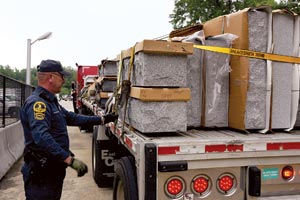Senior Reporter
Out-of-Service Rates Drop to New Lows at Roadcheck

Out-of-service rates for commercial vehicles and drivers dropped to record lows for inspections conducted during Roadcheck 2015, the Commercial Vehicle Safety Alliance announced last week.
The Level I inspection out-of-service rate declined to 21.6%, or 9,723 vehicles, from 23% last year. For drivers, the decrease was to 3.6%, or 1,623 drivers, from 4% of drivers in 2014.
The Level I inspection out-of-service rate has declined markedly since the event was first held in 1991, when such inspections resulted in 34.8% of vehicles and 5.6% of drivers being placed out of service.
“The Roadcheck results are encouraging, but people should be cautious in interpreting them,” said Rob Abbott, vice president of safety policy for American Trucking Associations. “Vehicles and drivers are targeted for [Level I] inspection based on past performance — not randomly selected — so we can’t draw conclusions about the overall population.”
Abbott added that the results are consistent with the Federal Motor Carrier Safety Administration’s claims that violations nationwide have been declining.
“This, too, is encouraging, but the emphasis should be on crash reduction,” Abbott said.
CVSA also said there were 777 seat belt violations issued during this year’s 72-hour enforcement blitz, down from 825 last year.
The vehicle out-of-service rate for Level I and all other inspections combined this year dropped to 17.5% from 18.7% in 2014, and the overall driver out¬of¬service rate this year matched the 4.8% rate in 2014.
“The CVSA Roadcheck numbers, particularly for vehicle out-of-service violations, continue to track the national average, which is slightly above 20%,” FMCSA spokesman Duane DeBruyne told Transport Topics. “On the driver side, the national average for out-of-service is 5.51%, so the Roadcheck results this year are encouraging — although there is no excuse for the 700-plus safety belt violations.”
Almost two of every three inspections conducted at this year’s event from June 2 to June 4 were Level I, the most rigorous check made by law enforcement. This year, there were more than 69,472 inspections, of which 44,989 were Level I.
William Schaefer, CVSA’s director of vehicle programs, said that because the Level I inspections are the most thorough they are arguably the best appraisal of a vehicle’s condition.
“I think that, in general, carriers are doing a good job at maintaining their vehicles and keeping their drivers in compliance,” Schaefer told TT.
Still, because the vehicles selected for Level I inspections are not randomly selected, Schaefer said he could not pinpoint the reason for the lowest ever out-of-service rates this year.
Carriers undergoing Level I inspections during the event were chosen by inspectors who keyed off such indicators as Compliance, Safety, Accountability scores and possible violations observed as trucks passed over scales or traveled highways.
Schaefer said that as data systems improve, inspectors get better every year at identifying those carriers that have a checkered inspection history.
This year’s enforcement emphasis was on proper load securement. Inspectors issued 2,439 violations for load securement during Roadcheck 2015, but Schaefer said that number was not a concern.
“Overall, the industry does a pretty good job with cargo securement,” Schaefer said. “But when it does happen, it can be a serious problem.”
The most frequent load-securement violations were for failure to prevent shifting or loss of load, failure to secure such truck equipment as tarps and improper tie-downs.
Inspectors in the United States and Canada took part in this year’s event.
“The results probably mean something. But I’m not sure what they mean,” said Henry Jasny, general counsel for the Advocates for Highway and Auto Safety. “Hopefully, it’s more than just a statistical glitch and that maybe CSA and the safety measurement system are working. But we don’t know.”

